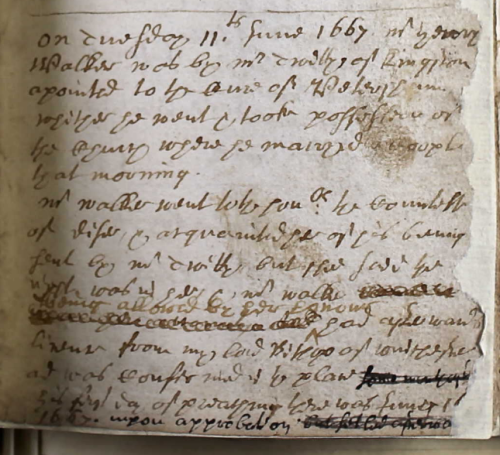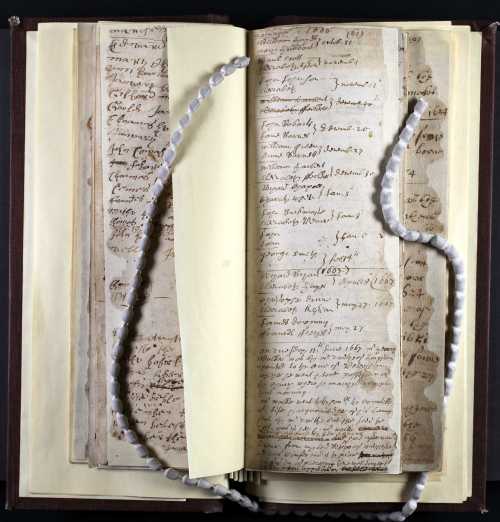In the summer of 1641 the poet and waterman John Taylor wrote a polemical pamphlet called A Reply as true as Steele attacking Henry Walker, in which he claimed Walker spoke with the:
Tongue of Saye.
Given the context – Taylor was attacking Walker for his anti-episcopal brand of puritanism – one might conclude that this is a reference to Viscount Saye and Sele, the éminence grise of the Warwick-Pym faction in Parliament. By the mid-1640s Walker had attached himself to Saye and the rest of the Independent part, and at least one historian has suggested that this is an early reference to that.
However, a closer look at the context of Taylor’s accusation suggests another possible interpretation. These are the lines in which the accusation appears:
Yet thou, (well skild in foolish impudence)
‘Gainst these retorting lines will take offence
And with Mockado mouth and judgement Rash,
And tongue of Saye , thou’lt say all is but trash,
And that ’tis pitty, I should thus disperse
A businesse of such consequence in verse.
The words in italics (Taylor’s/the printer’s, not mine) are all different forms of cloth. Mockado is a woollen imitation of velvet, introduced to England from Flanders in the mid-sixteenth century. Its roughness quickly made it a pseudonym for anything of inferior quality. Rash was a term for a wide range of wool or silk products, usually of a twill weave. And saye was another form of twill, woven in the south-west of England. Samuel Pepys bought a pair of green saye curtains for his parlour in June 1661.
So Taylor here is using Saye as part of an extended metaphor to criticise Walker’s literary credentials. Never one to resist blowing his own trumpet, he is probably also showing off his own cultural capital. In Measure for Measure the clown briefly mentions a character called Master Rash who is a money-lender. John Donne had also played upon this metaphor in one of his Satires:
Sir by your priesthood tell me what ye are!
His clothes were strange though coarse and black though bare
Sleeveless his jerkin was and it had been
Velvet but twas now (so much ground was seen)
Become tuff-taffety and our children shall
See it plain rash awhile then nought at all.
Still, it’s possible that the double meaning of the word may have had resonance with contemporaries as an insult. And as it happens I have found some evidence to suggest Henry Walker may have been linked to some of Saye’s fellow-travellers, if not Saye himself, as early as 1641. During the first half of that year two members of the Cheshire gentry, Sir Thomas Aston and Sir William Brereton, traded blows with each other via a series of petitions to Parliament.The quarrel was started by the root and branch petition put together by Calvin Bruen and others for Cheshire over the Christmas of 1640, and submitted to the Commons by Brereton on 19 February 1641.
Aston was incensed by the petition and mobilised signatures for his own petition to the Lords in favour of episcopacy, which he submitted on 27 February. A printed version was also published. At some point around the end of March or the start of April, a counter-petition emerged also claiming to be from Cheshire, but criticising episcopacy. This too was published: “many thousands” of copies according to Ashton later on in the year, although it was perhaps in his interest to exaggerate its impact and a print run in the hundreds seems more likely. According to Judith Maltby the counter-petition was orchestrated by Aston’s rival, William Brereton (although she doesn’t reference this). It was also a fake: it hadn’t been anywhere near the county of Cheshire and seems to have been intended instead as a tactical riposte to Aston’s pamphlet for a London audience.
As fakes go, it was a good one though. The printed version of the counter-petition was printed on the same size paper (as a broadside), and laid out in the same style with the same starting woodcut initial. However an alert reader might have concluded something was up when they read the numbers of signatories to each petition. Here are the signatories to Aston’s petition:
This petition was subscribed to by four noblemen, 80 and odd knights and esquires, 70 divines, 300 and odd gentlemen, and above 6,000 freeholders and other inhabitants.
And here are the signatories to Brereton’s:
This petition was subscribed to by eight noblemen, 199 knights and esquires, 140 divines, 757 gentlemen, and above 12,000 freeholders, and other inhabitants.
As you can see most of the figures have just been doubled to make a point.
The story of this exchange, and how it subsequently developed, was first told by John Morrill in his monograph on Cheshire and then developed by Maltby, who sees Aston’s petition as an example of prayer-book Anglicanism rising up to counter the growing anti-episcopal tendencies within Parliament. A classic example of the growth of a royalist opposition, then. But this account has subsequently been subject to an important revision by Peter Lake, who argues that Aston actually showed Laudian tendencies during the 1630s. He argues instead that Aston was trying to rally a wide spectrum of religious positions behind an inclusive definition of episcopal Anglicanism, to marginalise the hotter sort of Puritans such as Brereton.
However what none of the accounts mention is Henry Walker’s involvement with Brereton’s counter-petition. On 2 April Aston petitioned the Lords to complain about Brereton’s fake petition, and calling for justice on those involved in its circulation:
After this, a Petition of Sir Tho. Aston’s was read, in the Behalf of the County Palatine of Chester, against a Printed Petition, dispersed abroad as a Libel, in the Name of that County, which was supposed to be made by one Henry Walker, and sold by divers Stationers, and dispersed by others, whose Names were annexed unto the Petition; whereupon it was Ordered, That Henry Walker, Henry Hoode, Bankes, Thomas Bates, John Harrison, Bernard Alsop, and Tho. Fossett, be sent for, by the Gentleman Usher attending this House, to appear and answer the said Fact.
Six days later a number of these printers and booksellers named were brought to justice:
Ordered, That such of the Printers and Stationers, that were sent for upon the Complaint of Sir Thomas Aston, Baronet, and are charged in particular to have Hand in the libellous Petition, are to go upon reasonable Bail; and the Matter is referred to the Committee for examining the Printing of Libels, etc. But such of those that are not charged, are presently to be released out of the Custody of the Gentleman Usher.
What’s interesting about this is the number of people involved. Walker appears to have been the writer of the petition. At this point in 1641 he was drifting into writing and selling anti-episcopal books. Bankes (Thomas Banks) and Bates were two booksellers who were partners together. Walker’s books occasionally appeared in their stocks during the first half of 1641, although he seems to have had a quarrel with Bates later in the year while the pair were in prison for another offence. Harrison and Hoode are two other booksellers. Alsop and Fawcett were both printing partners about whom I’ve blogged previously, who would frequently be in trouble with the Long Parliament during 1641 and who printed many of Walker’s books in the same year.
So we have four booksellers distributing the fake petition. This is unusual: it could suggest a high print-run that needed to be dispersed quickly; or an attempt to share the blame if things went wrong; or something else entirely. And it’s equally unclear how they all came to be involved. Were they in it for the money? The flurry of petitions arriving at Parliament in the spring of 1641 may have meant this kind of product was particularly marketable. Or were their motives more political? Aston’s distinction between some of the stationers selling the petition, and others dispersing it, may mean some of them were giving it away. They would presumably have been funded to do so: either from their own money, suggesting strong political views, or by others who wanted to get this petition circulated as widely as possible.
Like most case studies of this type, we can ultimately only guess at what happened. But read in one way, it is possible that this is an early example of politicians making use of networks of stationers to get their messages out to a wider audience. Perhaps Brereton commissioned Walker directly to write the petition, recompensing him in return, and Walker in turn used his contacts in the book trade to get the pamphlet distributed quickly. Or perhaps it represents a more popular form of politics: Brereton only seems to have become associated with the counter-petition because of his rivalry and subsequent exchanges with Aston. If Walker was the instigator, it becomes instead an example of a relatively obscure individual, at home with underground religious and print networks, participating actively in a propaganda war. Either possibility is intriguing.
- omas Aston’s original petition in favour of episcopacy read in the Lords.
- Unknown date – Henry Walker’s fake petition against episcopacy.
- Unknown date – Aston produced his own petition, not circulated in the county. Is this the same as the critique of Walker et al?
- 2 April – Sir Thomas Aston’s petition against Walker’s libel. House adjourned into Committee but let him off after he explained himself.
- 19 April – petition of Calvin Bruen and others. Is this the Attestation? Refers back to another petition presented by William Brereton – but presumably this is the root and branch one?
- Unknown date – Aston drafted an answer to the Attestation.
- Unknown date – 43 gentry wrote a letter of support for Aston.
- November 1641 – Remonstrance against Presbytery.
- Unknown date – An Humble Remonstrance (E.178[4]) was the response.



